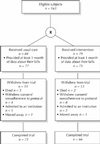A randomized controlled trial of a community-based consultation service to prevent falls
- PMID: 11563205
- PMCID: PMC81411
A randomized controlled trial of a community-based consultation service to prevent falls
Abstract
Background: Multifaceted programs that combine assessment with interventions have been shown to reduce subsequent falls in some clinical trials. We tested this approach to see whether it would be effective if offered as a consultation service using existing health care resources.
Methods: The subjects of this randomized controlled trial had to be aged 65 years or more and had to have fallen within the previous 3 months. They were randomly assigned to receive either usual care or the intervention, which consisted of in-home assessment in conjunction with the development of an individualized treatment plan, including an exercise program for those deemed likely to benefit. The primary outcomes were the proportion of participants who fell and the rate of falling during the following year. Visits to the emergency department and admissions to hospital were secondary outcomes.
Results: One hundred and sixty-three subjects were randomly assigned to either the control or the intervention group, and 152 provided data about their falls. There were no significant differences between the control and intervention groups in the cumulative number of falls (311 v. 241, p = 0.34), having one or more falls (79.2% v. 72.0%, p = 0.30) or in the mean number of falls (4.0 v. 3.2, p = 0.43). Analysis of secondary outcomes (health care use) also showed no significant differences between the intervention group and the control group. In the Cox regression analysis, there was no significant difference between the groups in the proportion of subjects having one or more falls (p = 0.55), but there was a significantly (p < 0.001) longer time between falls in the intervention group. In a post hoc subgroup analysis, subjects with more than 2 falls in the 3 months preceding study entry who had been assigned to the intervention group were less likely to fall (p = 0.046) and had a significantly longer time between falls (p < 0.001), when compared with the group who received usual care.
Interpretation: The intervention did not decrease significantly the cumulative number of falls, the likelihood of participants having at least one fall over the next year or the mean number of falls. It did increase significantly the time between falls in a survival analysis when age, sex and history of falling were used as covariates.
Figures
Comment in
-
Prevention of falls and subsequent injuries in elderly people: a long way to go in both research and practice.CMAJ. 2001 Sep 4;165(5):587-8. CMAJ. 2001. PMID: 11563210 Free PMC article. No abstract available.
References
-
- Sattin RW. Falls among older persons — a public health perspective. Annu Rev Public Health 1992;13:489-508. - PubMed
-
- Stokes J, Lindsay J. Major causes of death and hospitalizations in Canadian seniors. Chron Dis Can 1996;17(2):63-73. - PubMed
-
- Wilkins K. Health care consequences of falls for seniors. Health Rep 1999; 10(4):47-55. - PubMed
-
- The Canadian Task Force on the Periodic Health Examination. The Canadian guide to clinical preventive health care. Ottawa: Canada Communication Group; 1994. p. 920.
-
- Wolf-Klein GP, Silverstone FA, Basavaraju N, Foley CJ, Parcaru A, Ma PH. Prevention of falls in the elderly population. Arch Phys Med Rehabil 1988; 69:689-91. - PubMed
Publication types
MeSH terms
LinkOut - more resources
Full Text Sources
Medical


